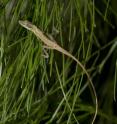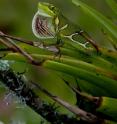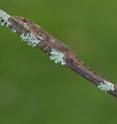Competition puts the brakes on body evolution in island lizards
Millions of years before humans began battling it out over beachfront property, a similar phenomenon was unfolding in a diverse group of island lizards. Often mistaken for chameleons or geckos, Anolis lizards fight fiercely for resources, responding to rivals by doing push-ups and puffing out their throat pouches. But anoles also compete in ways that shape their bodies over evolutionary time, says a new study in the journal Evolution.
Anolis lizards colonized the Caribbean from South America some 40 million years ago and quickly evolved a wide range of shapes and sizes. "When anoles first arrived in the islands there were no other lizards quite like them, so there was abundant opportunity to diversify," said author Luke Mahler of Harvard University.
Free from rivals in their new island homes, Anolis lizards evolved differences in leg length, body size, and other characteristics as they adapted to different habitats. Today, the islands of Cuba, Hispaniola, Jamaica and Puerto Rico — collectively known as the Greater Antilles — are home to more than 100 Anolis species, ranging from lanky lizards that perch in bushes, to stocky, long-legged lizards that live on tree trunks, to foot-long 'giants' that roam the upper branches of trees.
"Each body type is specialized for using different parts of a tree or bush," said Mahler.
Alongside researchers from the University of Rochester, Harvard University, and the National Evolutionary Synthesis Center, Mahler wanted to understand how and when this wide range of shapes and sizes came to be.
To do that, the team used DNA and body measurements from species living today to reconstruct how they evolved in the past. In addition to measuring the head, limbs, and tail of over a thousand museum specimens representing nearly every Anolis species in the Greater Antilles — including several Cuban species that were previously inaccessible to North American scientists — they also used the Anolis family tree to infer what species lived on which islands, and when.
By doing so, they discovered that the widest variety of anole shapes and sizes arose among the evolutionary early-birds. Then as the number of anole species on each island increased, the range of new body types began to fizzle.
Late-comers in lizard evolution underwent finer and finer tinkering as time went on. As species proliferated on each island, their descendants were forced to partition the remaining real estate in increasingly subtle ways, said co-author Liam Revell of the National Evolutionary Synthesis Center in Durham, NC.
"Over time there were fewer distinct niches available on each island," said Revell. "Ancient evolutionary changes in body proportions were large, but more recent evolutionary changes have been more subtle."
The researchers saw the same trend on each island. "The islands are like Petri dishes where species diversification unfolded in similar ways," said Mahler. "The more species there were, the more they put the brakes on body evolution."
The study sheds new light on how biodiversity comes to be. "We're not just looking at species number, we're also looking at how the shape of life changes over time," said Mahler.
The team's findings will be published this week in the journal Evolution.
Source: National Evolutionary Synthesis Center (NESCent)
Other sources
- Competition puts the brakes on body evolution in island lizardsfrom PhysorgFri, 18 Jun 2010, 14:32:07 UTC


